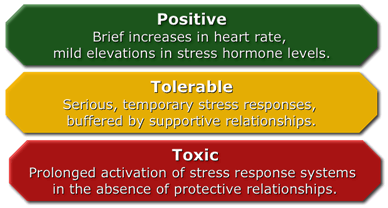What is Toxic Stress
Stress is the body’s physiological and cognitive response to situations/events we perceive as threats or challenges. It is a normal and natural response. The National Scientific Council on the Developing Child proposed three distinct forms of stress responses in young children: Positive, tolerable, and toxic.1, 2 Let’s start with the latter because it is considered as the most dangerous or harmful type of stress response. Exposure to stressful and adverse experiences over a long period of time can become toxic. This repeated exposure to stress without the benefit of buffering protection of a supportive, adult relationship has been termed toxic stress.1, 2 Several adverse life events may contribute to toxic stress response include neglect and abuse, divorce/separation, death of a loved one, exposure to domestic violence, incarceration of a parent or a family member, neighborhood violence, extreme poverty, parent or family member abusing drugs/alcohol, parent or caregiver having a mental illness, neglect. Exposure to toxic stress can have detrimental short and long-term physical and mental health consequences on both children and adults.

Tolerable Stress: “A tolerable stress response is associated with exposure to non-normative experiences that present a greater magnitude of adversity or threat.”1 Examples of this type of stress response include experiencing the death a family member, a serious illness or injury, natural disaster, an act of terrorism. What makes this types of stress response tolerable is having the protection provided supportive adult relationships that enhances the child’s ability to cope and gain a of sense control. This helps to “reduce the physiologic stress response and promote a return to baseline status.”
Positive Stress: “A positive stress response refers to a physiologic state that is brief and mild to moderate in magnitude.”1 This type of stress response can be alleviated with the assistance of a caring and responsive adult who help the child cope with the stressor. In this context, the presence of a caring and responsive adult plays the role of a protective factor because it allows the child’s stress response to return to the original state or baseline. Examples of stressors that trigger positive response in children include dealing with frustration, anxiety associated with being in novel situations or environments, getting immunization.
References
1Shonkoff, J. P., Garner, A. S., Siegel, B. S., Dobbins, M. I., Earls, M. F., McGuinn, L., . . . Wood, D. L. (2012). The lifelong effects of early childhood adversity and toxic stress. Pediatrics, 129(1), e232-e246. doi:http://dx.doi.org/10.1542/peds.2011-2663.
2 Shonkoff, J. P., Boyce, W. T., & McEwen, B. S. (2009). Neuroscience, molecular biology, and the childhood roots of health disparities building a new framework for health promotion and disease prevention. JAMA: Journal of the American Medical Association, 301(21), 2252-2259. doi:http://dx.doi.org/10.1001/jama.2009.754

